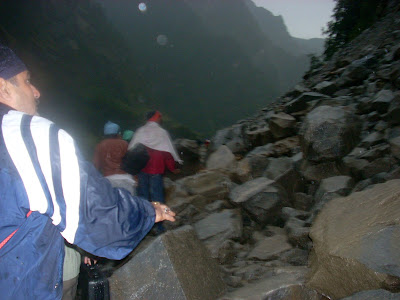This is a series of my two weeks of tryst with the Garhwal Himalayas:
3 am: My eyes opened at 3 in the morning. I found myself coiled up inside the blanket shivering. It was chilling. I couldn't make out if it was cold or I had a fever. I confirmed and was glad to find was the former. For the next two hours, I lay in bed staring blankly contemplating the next course of action.
6 am: I check out of my room feeling fresh and ready for the day ahead. And what do I see outside? I am surrounded by green peaks around. I am amidst the mountains. There is no feeling more enthralling than this. I take tea from the dhaba and go for a morning stroll. I have no clue of the land slide is cleared on the road ahead. But its lovely. I can also hear the gushing sounds of river Alakananda far below.
I ask the conducter to pick me on the way once the blockade gets cleared. I leave the place and walk along the road.

I took a lot of pictures of the morning scenery.

I then reached the spot of land slide. The BRO official was busy
maneuvering the roller to clear off the road. I saluted him for his duty that took more than 2 hours.

I kept
walking ahead and met some local kids. The kids showed me around and posed for a lot of pictures.
I kept walking ahead. Each new turn on the road, presented a new panorama, a new landscape as beautiful as the other. I would have walked for an hour now, but
wasn't feeling tired at all. nature's effect may be.
And then I took another turn...
My eyes met something. I shouted at the spot. I howled, I shrieked at the top of my voice till it ached. I saw the first snow
cliffed mountain in my life.

I looked around to share my excitement. There was no one. Only the valley and me and the barren road. I kept shouting and jumping. Frantically tried my cell, but of no avail.
The view looked heavenly. Also a little scary. I do not know why. It was so high touching the sky and actually looked like God's abode. The morning walk was worth taking. I experienced a special moment of my life.
Meanwhile a volley of vehicle's crossed me. I think the road blockade was removed. I looked for my bus amongst them. Then it came. And it crossed by me without stopping. My backpack was in there. The driver
couldn't recognize me. I gave a shout and waved frantically. A moment later it screeched to a halt. I had my heart in my mouth a moment before.
9:20: We reached
Joshimath. The driver was in a hurry to cross the
town early for some reason. Alas!, he
couldnt. The
checkpost in
Joshimath was closed at 9:30 am. And would open only at 11:30.
Joshimath to Badrinath
Joshimath to Badrinath road remains open for 6 months (April to October) and closed the other 6 months. During active months, the traffic is managed with gate systems that allow traffic only one way in phases. The gates open at 6:30, 9:30, 11:30, 14:00 and 16:30.
Tip: If you are travelling through
Joshimath, remember the gate timings.
We missed the gate by a whisker and were to be stranded for 2 hours. I was in no mood to wait doing nothing. I got down, had some aloo parathas and got to my business of walking. I walked and walked and walked for the next 2 hours amidst breathtaking views again.

Met a
gorkha on the way who chatted and walked along with me for a while. Crossed an army cantonment. I walked
around 10
kms in 2 hours. And then my bus came and picked me up.
The first 15
kms of the 50
kms stretch is uneventful and amidst peaceful valley. What comes after that will make you shudder. Words fail to describe the roads and the ghats that come next.
Atleast I
dont have the ability to describe. The roads are so narrow that a faintest lapse of concentration or a lack of sense of measure would land you into the
Alakananda below.
The ghats stood in
ominous pose on either side of the
Alakananda. This was the first time in 2 days of travelling amidst mountains, I was petrified. The older travellers in the bus were chanting prayers to calm themselves down. With numerous blind curves that crossed many water streams, we kept gaining altitude. We reached
Badrinath at 1 pm.































